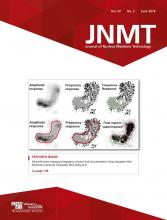Richard Siska
A Nuclear Medicine Advanced Associate (NMAA) is defined as a physician extender trained through a master’s degree–level program and certified by the Nuclear Medicine Technology Certification Board (NMTCB) who, working under the supervision of a licensed physician, enhances patient care in the diagnostic imaging and radiotherapy environments. The Society of Nuclear Medicine and Molecular Imaging Technologist Section (SNMMI-TS) spent many years researching and creating a mid-level provider pathway for technologists interested in assuming advanced-level patient care responsibilities in the nuclear medicine environment. The need for mid-level providers is prevalent and has been proven useful in many areas of medicine—as demonstrated by the Radiologist Assistant (R.A), which has gained increasing professional status over the last several years. Since the NMAA was first proposed in the early 2000s, the number of nuclear medicine residency programs has declined, which has also demonstrated a need for mid-level providers within the nuclear medicine and molecular imaging field.
In 2008, the SNMMI approved the Nuclear Medicine Advanced Associate Curriculum Guide, and in 2009 the first class of the NMAAs entered the program through the University of Arkansas for Medical Sciences and a consortium of supporting universities. In 2010, the Scope of Practice for the Nuclear Medicine Advance Associate was formally approved, and in 2011, the first graduates of the program sat for the first NMAA certification exam and entered the field. As with many new designations, there was an initial lack of state or federal recognition, and to this day only a handful of states have introduced or passed licensure for the NMAA. However, in 2018, the SNMMI Board of Directors formally endorsed the NMAA as the official “physician extender” for nuclear medicine, which may help ignite renewed interest for further states to adopt legislation recognizing the profession.
In 2015, a stakeholders meeting for the NMAA took place in Chicago where representatives from different organizations such as the American College of Radiology, SNMMI, Joint Review Committee on Educational Programs in Nuclear Medicine Technology, and American Society of Radiologic Technologist agreed that a template to open new programs and expand the numbers of NMAAs entering the field needed to be created. In San Diego, at the 2016 SNMMI annual meeting, the Advanced Associate Council from the SNMMI and the NMTCB formed a task force to accomplish this task. In 2018, the task force released the NMAA Educational Program Recognition Guidelines (https://www.nmtcb.org/documents/NMAA-Educational-Program-Recognition-Guidelines-Final-2019.pdf), which outlines the minimum criteria that an educational program must achieve to have their graduates be deemed eligible to sit for the NMTCB’s NMAA advanced certification examination. The Guidelines explain the expectation the education of a nuclear medicine advanced associate will be granted through a nationally accredited academic program that is offered at a master’s degree level and will encompass the nationally recognized Nuclear Medicine Advanced Associate Curriculum Guide.
The professional curriculum is expected to utilize a competency-based model in which responsibilities and functions are defined by clinical competencies integrated with physician interaction and supervision. Education programs will be outcomes-based and must provide learning opportunities in each competency domain. Assessment of student achievement in each of the domains should be undertaken at multiple intervals using multiple assessment methods.
The sponsoring institution of a NMAA educational program must be accredited by a recognized regional, national, and/or state agency and be legally authorized to provide a program of postsecondary education. All academic affiliates must be accredited by a recognized regional, national, and/or state agency.
While the previous NMAA educational model was delivered in a manner primarily as an online distance learning format, the current NMAA Educational Program Recognition Guidelines document does allow for didactic coursework to be completed either through face-to-face instruction, online delivery, a hybrid model (online instruction mixed with some traditional classroom instruction), or by collaboration with other institutions for instructive delivery.
In an NMAA program, the physician preceptors are extremely significant to success in the training and education of the NMAA student. The preceptors operate in much the same way as seen in a doctoral program where insight and experience can be passed to the intern in correlation to didactic training. NMAA students (or “intern”) can obtain their clinical instruction at their own place of employment. In some instances, the NMAA intern may be required to travel to other clinical sites in order to obtain all of the competencies that are needed for program completion.
Any NMAA Program that would like to have its graduates sit for the NMTCB’s NMAA certification exam should meet the guidelines listed in the guidelines document and complete the application to the NMTCB. Interested parties can visit the NMTCB’s NMAA webpage (https://www.nmtcb.org/specialty/NMAAExam.php) for additional information and access to a variety of NMAA-specific documents.









